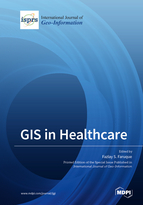GIS in Healthcare
A special issue of ISPRS International Journal of Geo-Information (ISSN 2220-9964).
Deadline for manuscript submissions: closed (31 July 2021) | Viewed by 70973
Special Issue Editor
Interests: geospatial health; environmental health; landscape epidemiology; population health geography; geospatial health disparities; geospatial analysis of eco-social determinants; application of earth observation resources in health studies
Special Issues, Collections and Topics in MDPI journals
Special Issue Information
Dear Colleagues,
The entire healthcare sector, including health businesses, academia, and policy makers, is facing a challenge to become more efficient by reducing costs while reaching out to a broader range of communities. GIS is a proven tool for improving efficiency and planning in different areas of healthcare. From non-critical applications, such as primary care or preventive care, to critical situations, such as emergency care or organ replacement, GIS is increasingly being utilized to develop better business models and make lifesaving decisions. This Special Issue of IJGI is expected to serve as a knowledge exchange platform presenting the latest advancements in GIS applications in a dynamic healthcare landscape.
We invite authors to submit original scientific papers on the application of geospatial technologies in healthcare including, but not limited to, the following topics:
- Catchment area;
- Distance decay;
- Drive time pattern;
- Healthcare business model;
- Healthcare geomatics;
- Healthcare disparities;
- Healthcare needs assessment and planning;
- Healthcare shortage areas;
- Healthcare utilization;
- Healthcare resource allocation;
- Remote patient monitoring;
- Social medicine;
- Spatial surveillance;
- Telehealth.
Prof. Fazlay S. Faruque
Guest Editor
Manuscript Submission Information
Manuscripts should be submitted online at www.mdpi.com by registering and logging in to this website. Once you are registered, click here to go to the submission form. Manuscripts can be submitted until the deadline. All submissions that pass pre-check are peer-reviewed. Accepted papers will be published continuously in the journal (as soon as accepted) and will be listed together on the special issue website. Research articles, review articles as well as short communications are invited. For planned papers, a title and short abstract (about 100 words) can be sent to the Editorial Office for announcement on this website.
Submitted manuscripts should not have been published previously, nor be under consideration for publication elsewhere (except conference proceedings papers). All manuscripts are thoroughly refereed through a single-blind peer-review process. A guide for authors and other relevant information for submission of manuscripts is available on the Instructions for Authors page. ISPRS International Journal of Geo-Information is an international peer-reviewed open access monthly journal published by MDPI.
Please visit the Instructions for Authors page before submitting a manuscript. The Article Processing Charge (APC) for publication in this open access journal is 1700 CHF (Swiss Francs). Submitted papers should be well formatted and use good English. Authors may use MDPI's English editing service prior to publication or during author revisions.
Keywords
- accessibility
- geospatial health
- GIS
- healthcare
- healthcare delivery
- needs assessment
- service area
- spatial disparities
- spatial modeling






